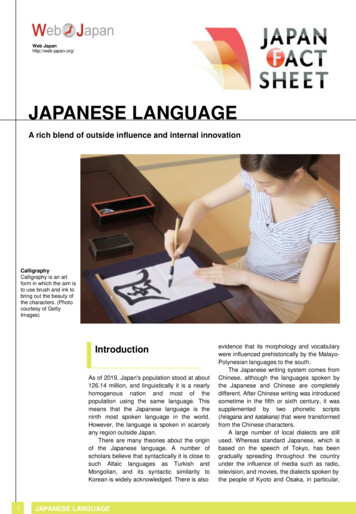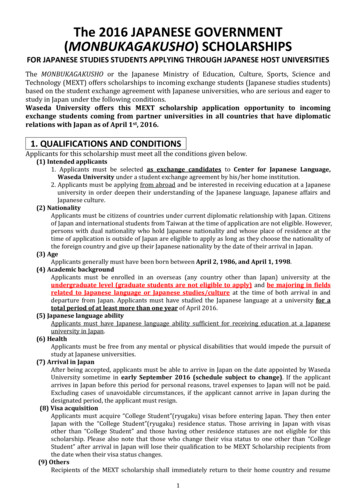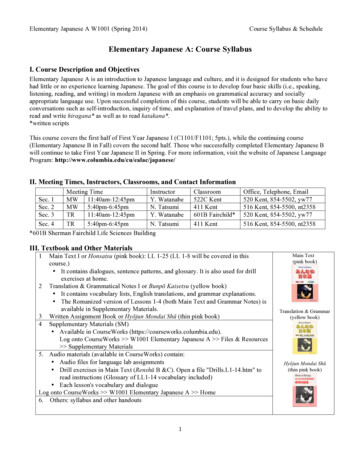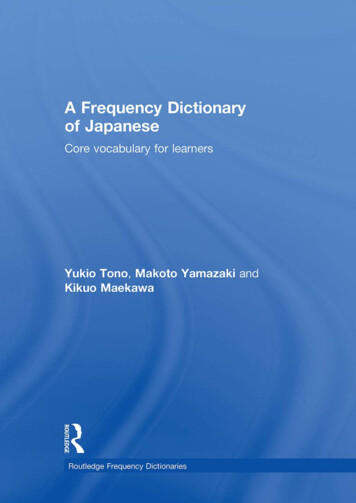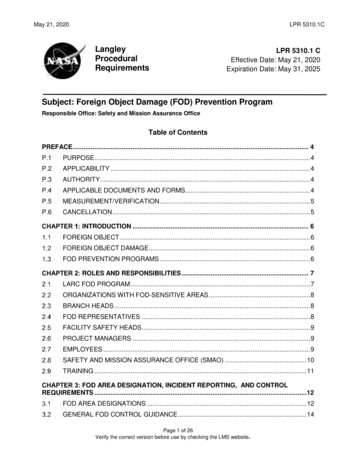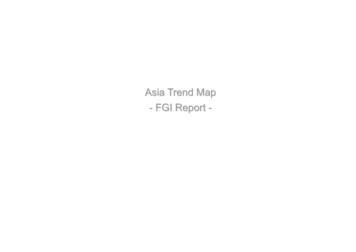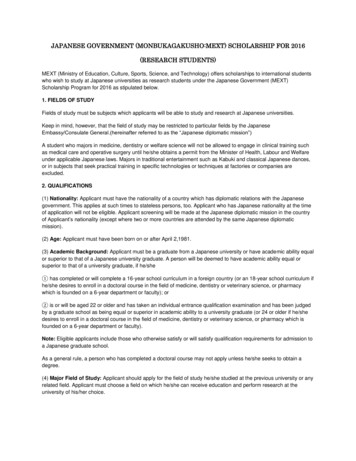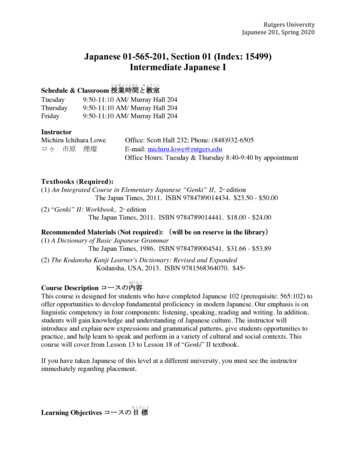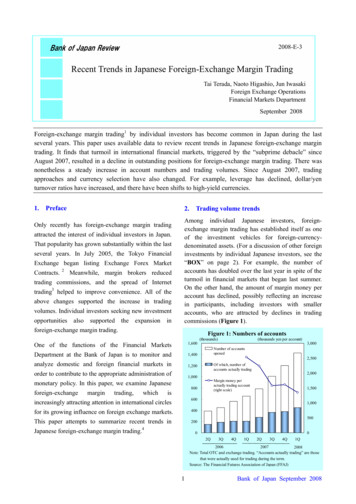
Transcription
2008-E-3‴⁓ ⁝‒ ⁘‒‼⁓ ⁓ ‒ ⁗ ⁛⁗ ‒Recent Trends in Japanese Foreign-Exchange Margin TradingTai Terada, Naoto Higashio, Jun IwasakiForeign Exchange OperationsFinancial Markets DepartmentSeptember 2008Foreign-exchange margin trading1 by individual investors has become common in Japan during the lastseveral years. This paper uses available data to review recent trends in Japanese foreign-exchange margintrading. It finds that turmoil in international financial markets, triggered by the “subprime debacle” sinceAugust 2007, resulted in a decline in outstanding positions for foreign-exchange margin trading. There wasnonetheless a steady increase in account numbers and trading volumes. Since August 2007, tradingapproaches and currency selection have also changed. For example, leverage has declined, dollar/yenturnover ratios have increased, and there have been shifts to high-yield currencies.1.Preface2.Only recently has foreign-exchange margin tradingattracted the interest of individual investors in Japan.That popularity has grown substantially within the lastseveral years. In July 2005, the Tokyo FinancialExchange began listing Exchange Forex MarketContracts.2Meanwhile, margin brokers reducedtrading commissions, and the spread of Internettrading3 helped to improve convenience. All of theabove changes supported the increase in tradingvolumes. Individual investors seeking new investmentopportunities alsosupportedtheexpansioninTrading volume trendsAmong individual Japanese investors, foreignexchange margin trading has established itself as oneof the investment vehicles for foreign-currencydenominated assets. (For a discussion of other foreigninvestments by individual Japanese investors, see the“BOX” on page 2). For example, the number ofaccounts has doubled over the last year in spite of theturmoil in financial markets that began last summer.On the other hand, the amount of margin money peraccount has declined, possibly reflecting an increasein participants, including investors with smalleraccounts, who are attracted by declines in tradingcommissions (Figure 1).foreign-exchange margin trading.Figure 1: Numbers of accounts(thousands)One of the functions of the Financial Markets1,600Department at the Bank of Japan is to monitor and1,400analyze domestic and foreign financial markets in1,200order to contribute to the appropriate administration of1,000monetary policy. In this paper, we examine nds yen per account)3,000Number of accountsopened2,500Of which, number ofaccounts actually trading2,000Margin money peractually trading account(right scale)800is1,500600increasingly attracting attention in international circlesfor its growing influence on foreign exchange markets.400This paper attempts to summarize recent trends in200Japanese foreign-exchange margin e: Total OTC and exchange trading. “Accounts actually trading” are thosethat were actually used for trading during the term.Source: The Financial Futures Association of Japan (FFAJ)1Bank of Japan September 2008
Likewise, a review of quarterly trading volumes forforeign-exchange margin trading indicates that themarket has more than quadrupled from just over 50trillion yen during the first quarter of 2006 to 230trillion yen during the first quarter of 2008 (Figure 2).Figure 2: Japanese foreign-exchange margin(trillion yen)trading volume250Exchange tradingWhile direct comparisons are difficult,5 the volume offoreign-exchange margin trading is equivalent toabout 10% of total yen spot trading, according toglobal statistics kept by the BIS (as in April 2007). 6This data indicates that individual Japanese investorsare becoming important participants in the foreignexchange market, joining domestic and foreigninstitutional investors, importers, exporters and hedgefunds (Figure 3).200Figure 3: Daily average trading volumecomparisonsOTC trading150Yen spot trading volume (global base, BIS figures)April 200724.5 trillion yen (*) per dayJapanese foreign-exchange margin trading volume(total OTC and exchange trading, FFAJ figures)1001st quarterof 20071st quarterof 20085001Q2Q3Q4Q1Q2Q3Q4Q1.9 trillion yen per day (7.7% )3.6 trillion yen per day ( 14.5% )(*) 206.0 billion USD(Conversion rate: Dollar/yen 118.81)1Q200620072008Note: Total buying and selling transactions reported by FFAJ members(securities companies, futures companies etc.)Source: FFAJNote: Figures in parentheses ( ) in the Japanese margin tradingvolume column are ratios against global-based yen spot tradingvolumes (April 2007)Sources: The Bank for International Settlements (BIS), FFAJ[BOX] Investments in foreign-currency-denominated assets by individual Japanese investors:Comparison of foreign-currency-denominated investment trust and foreign-exchange margin tradingOther than foreign-exchange margin trading, individualJapanese investors use several tools to invest inforeign-currency-denominated assets. Those are foreigncurrency-denominated investment trusts, investments inbond placements and other foreign securities and foreigncurrency deposits. Among them, investments in foreigncurrency-denominated investment trusts have enjoyed asignificant acceleration in growth since 2002.Nonetheless, in the latter half of 2007, outstandingbalances posted a slight decline (Box Figure 1).margin trading had a trading volume of 739.6 trillion yenin FY 2007 (from April 2007 to March 2008; figuresfrom FFAJ; aggregate of OTC and exchange trading).In terms of foreign exchange markets, trading throughinvestment trusts is considered to have a relatively largeinfluence from the perspective of a long-term supply anddemand for currencies. Meanwhile, foreign-exchangemargin trading has a relatively large impact on shortterm market movements and market liquidity due to itstrading flow.Comparing the size of each foreign-currencydenominated asset class as of the end of March 2008, ona stock basis, foreign-exchange margin trading had anoutstanding balance (gross positions) of 3.1 trillion yen.This was significantly smaller than the balance onforeign-currency-denominated investment trusts (32.1trillion yen), according to the Investment TrustsAssociation, Japan. It is also smaller than outstandinghousehold outward investment in securities (12.2 trillionyen) and foreign currency deposits (4.8 trillion yen) inthe Flow of Funds Accounts (Bank of Japan).Box Figure 1: Outstanding balances in foreigncurrency-denominated investment trusts40(trillion yen)35Other30Equity25Bonds201510However, unlike other foreign investments, it is notunusual for foreign-exchange margin trading to seemultiple trades during a single day, and indeed the highfrequency of trading is one of its distinguishing features.Measuring sizes on a flow basis, urce: The Investment Trusts Association, Japan (ITAJ)2Bank of Japan September 2008
To identify the basic distinguishing features ofJapanese foreign-exchange margin trading, we lookedat the positions of foreign-exchange margin traders onthe Tokyo Financial Exchange (TFX) and noncommercial, non-reportable investor positions on theIMM, a division of the Chicago Mercantile Exchange.The latter are considered to be the positions taken bysome hedge funds and other short-term wholesaleinvestors. Comparing the positions of both players, weidentified the following distinctive features ofJapanese foreign-exchange margin trading.(1) Trading primarily takes the form of“yen-shorts and foreign currency-longs”Looking at the trends in Japanese margin tradingpositions from a slightly long-term perspective, onecan see that they change according to marketenvironments, but primarily take the form of sellingyen and buying foreign currency.For example, in the dollar/yen market, short-termwholesale investors have had positions that are eitherdollar-long or yen-long, depending upon changes inthe market. At the same time, positions for Japaneseforeign-exchange margin trading have basicallyalways been dollar-long (yen-short) even when thedollar/yen rate fell below 100 yen in March 2008(Figure 4).7Active attempts by individual Japanese investors touse foreign-exchange margin trading to earn profits oninterest rate differentials (the “carry”) are said to bebehind this “selling yen and buying foreign currency”feature. In other words, in foreign-exchange margintrading, taking long positions in relatively high-yieldcurrencies results in daily additions to earnings fromthe carry (swap points). Individual Japanese investorstry to earn these profits by going short in yen, which isa low-interest rate currency, and simultaneously goinglong in high-yield currencies (can be referred to as“carry trades”8).(2) Investors primarily take positions againstshort-term market directionsFrom a short-term perspective on the positions inJapanese foreign-exchange margin trading and thepositions of short-term wholesale investors, the lattergenerally align their positions with short-term marketdirections, while the former tends to build contrarypositions that go against short-term market directionsas long as the amount of fluctuation does not exceed acertain level (Figure 5).9Figure 5: Change in net positions for Japanesemargin traders and IMM short-term investors,and their relationship to dollar/yen rate(yen/dollar)䋫5.0Weekly change in dollar/yen market3. Distinguishing features of trading andinvestment approachesFigure 4: Japanese FX margin trading and IMMshort-term investors net positions (dollar/yen)(x 10,000 contracts)(yen/dollar)䋫20130Period: July 10, 2006August 15, 2008USD long䋫15䋫10124118Japanese margin positionsIMM non-commercial, non-reportable positions䋫2.5䋫0.0䂥 2.5Week of August 14, 2007 *Week of March 11, 2008 *䂥 5.0䋫5JPY long䋫0䂥5䂥 10Jul-06䂥 10.0112106IMM positionsMargin trading positionsDollar/yen (right scale)Jul-07Jan-08Jul-08Notes: Net positions long positions - short positions. For Japanese margintrading, positions on Tokyo Financial Exchange (TFX) trading are used.For IMM short-term trading, positions of weekly totals fornon-commercial, non-reportable investors are used.Sources: TFX, Commodity Futures Trading Commission (CFTC), 0.0 5.0 10.0Notes: Weekly data (period: July 11, 2006-August 12, 2008)See Note 9 for entries marked with *Sources: TFX, CFTC, Bloomberg10094Jan-07䂥 5.0Weekly change in degree of(x 10,000 contracts)dollar-long/yen-short positionsWhile Japanese individual investors are basicallytrying to earn profits on interest rate differentials,when the market goes up (weaker yen, strongerforeign currencies), they tend to lock in profits fromthe appreciation of the foreign currency with reducingpositions in preparation for future price declines.3Bank of Japan September 2008
Conversely, when the market is in decline (strongeryen, weaker foreign currencies), they tend to increasetheir long foreign currency positions as they considerthat the potential for losses from future marketdeclines has been reduced. In addition, as will bediscussed below, recently there has been an increase intrading that seeks capital gains, including taking shortpositions on the US dollar. Even in this trading forcapital gains, retail players appear to primarily takecontrary positions, buying into declines and sellinginto gains, unless there is wide divergence from therange initially anticipated. This feature of foreignexchange margin trading makes it a factor inestablishing a certain limit on market fluctuations aslong as the change in market levels is not too abrupt.4.Recent developments and changesHaving discussed the basic features of this segment ofthe market, we now turn to developments in foreignexchange margin trading since the start of globalfinancial market turmoil last summer.(1) Changes that took place around August 2007Accumulation and unwinding/foreign currency-long positionsofand the reverberations expanded to internationalfinancial markets, the yen turned upwards on theforeign exchange market, which resulted in asignificant unwinding of positions. Of particular noteis August 16, the date on which the dollar/yen rateplummeted through 115 yen. Large numbers offoreign-exchange margin positions were liquidatedunder automatic loss cutting rules.10 The closure oflong dollar/yen positions during the decline had animpact on market trends and is viewed as a factor inaccelerating the appreciation of the yen during thisperiod (Figure 6-(1)).11Decline in leverage12The higher the leverage (ratio of open positions tomargin money) is, the greater the potential is forchanges to be accelerated, for example, by automaticloss cutting when there are significant movements inthe market. Estimates indicate that the averageleverage at the third quarter of 2007 was noticeablylower than the second quarter of 2007 (Figure 7).Presumably, this was because the automatic losscutting rules described above came into play inAugust 2007, closing out highly-leveraged positions.yen-shortFigure 7: Average leverage10During 2007, and particularly in July and early August,Japanese margin trading saw a surge in carry tradesand a sharp increase in long positions in US dollarsand other currencies (short in yen). However, whenthe short-term money markets were shaken by thesubprime problems through the middle of August8(Multiple)8.57.866.1Aggregate of OTC and exchange tradingExchange tradingFigure 6: Total positions (exchange trading base)OTC trading(trillion yen)(1)Yen Q2008Long positionsSource: FFAJ䋫0.385US dollar/yen䋫0.2NZ dollar/yenAus dollar/yen䋫0.1Short positions䋫0.0䂥 0.1Euro/yen(2) Changes since August 20078075British pound/yenYen/nominal effective exchange rate(right scale)Changes in dollar/yen trading: Increase in shortpositions and higher turnover ratios7065(2)䂥 0.2Jan-07 Apr-07 Jul-07 Oct-07 Jan-08 Apr-08 Jul-08Note: Yen/nominal effective exchange rate calculated by JP MorganSources: TFX, Bloomberg60Looking at developments in Japanese retail margintrading since August 2007, one of the majorcharacteristics has been the increase in dollar-shortpositions since March 2008 (Figure 6-(2)). In addition,turnover ratios (i.e., trading volume divided byoutstanding positions) have also increased, suggesting4Bank of Japan September 2008
more short-term trading (Figure 8).Figure 9: Net position trend (by currency pair)Behind this are the lower costs for taking dollar-shortpositions due to a contraction of the interest ratedifferentials, which can also be observed in thedecline in the carry vs. volatility index (Figure 8).Meanwhile, the increased volatility in the market hasled to an increase in short-term trading targeted toearn capital gains. This occurred as investors solddollars at the peak and then bought them back atcheaper prices thereafter. Another point quite oftenmade with respect to these trading trends is thatdeclines in trading commissions have contributed toreducing the cost of short-term trading.䋫0.20(trillion yen)NZ dollar/yenUS dollar/yenNet long䋫0.15䋫0.10Net short䋫0.05䋫0.00䂥 ces: TFX, BloombergFigure 8: Turnover ratio and carry vs.volatility index (US 61.20.40.8Turnover ratio0.20.4Carry vs. volatility index(right scale)0.00.01Q2Q3Q20074Q1Q2008Notes: Turnover ratio Average daily trading volume (OTC trading) Outstanding positions (total of long and short as of end of period)Carry vs. volatility index 3-month LIBOR interest-rate spread 3-month implied volatilitySources: FFAJ, BloombergShift out of US dollars in favor of high-yieldcurrenciesForeign-exchange margin trading, which is primarily avehicle for individual Japanese investors, has anincreasing presence in foreign exchange markets andtrends within the segment help drive marketmovements. Looking at overall trends in foreignexchange margin trading, trading features andapproaches have changed in response to the changesin international financial markets since August of lastyear.Points to watch with respect to foreign-exchangemargin trading and its impact on foreign exchangemarkets include: (1) changes in the investmentapproaches used in foreign-exchange margin trading;(2) changes in leverage; and (3) changes in currencyselection. (In particular, the presence of Japaneseforeign-exchange margin trading cannot be ignoredfor relatively less traded currencies that do not havethe same scale of trading as the US dollar or Euro[Figure 10]).There have also been changes since August 2007 inthe selection of currencies for margin trading.Successive policy rate cuts in the United States havesignificantly narrowed the Japan-US interest-ratespread and prompted a shift to high-yield currenciesthat offer higher earnings from interest rate spreads.One example can be seen from the positions in theNew Zealand dollar vs. the yen. With an official cashrate of 8% (as of August 19, 2008), New Zealand wasone of the highest of the major currencies, andbetween March and August 2008, there was asignificant increase in long New Zealand dollarpositions against yen (Figure 9).13Figure 10: Daily average trading volumeForeign-exchangespot trading volume(global base,BIS figures,April 2007)- trillion yen(*) (a)US dollarEUROBritish poundSwiss FrancsAus dollarCanadian dollarNZ dollarRandJapanese FXmargin tradingOTC trading volume(FFAJ figures, 1stquarter of 2008)vs. yen trading- trillion yen (b) 44.570.032.050.090.670.02(*) Conversion rate: US Dollar/yen ))))Sources: BIS, FFAJ5Bank of Japan September 2008
1Foreign-exchange margin trading is a currency trade in whichmargin money is deposited as security with a broker and trades aresettled "on the margin" (the difference in prices). This form oftrading first expanded with the 1998 amendments to the ForeignExchange and Foreign Trade Control Act. In July 2005 it wasbrought under the Financial Futures Trading Act.2When investors engage in foreign-exchange margin trading, theymay either trade on the exchange through a margin broker(exchange trading) or trade directly with a margin broker (OTCtrading) (see the figure below).(Exchange trading)Source: TFXMarginTradingForeign exchange marketTradingTradingMargin inFinancialinstitutionMarginExchangeTradingMargin brokerIndividual investorMarginTrading(OTC trading)3Investors primarily engage in margin trading through Internetand telephone accounts. According to data released by theFinancial Futures Association of Japan (FFAJ), the share ofaccounts using the Internet for transactions (number of accountsactually used for trading during the period) has risen from 87.9%(second quarter of 2006) to 97.4% (first quarter of 2008). Duringthis period, the number of Internet accounts increased 232.2%,while the number of telephone accounts declined 35.0%.4Investors who engage in foreign-exchange margin trading areexposed to foreign-exchange fluctuation risk. This paper does notrecommend foreign-exchange margin trading, nor does itrecommend any specific investment techniques or approaches.5Some margin brokers offset purchase orders and sales ordersfrom individual investors who are their clients and take only theremainder to the foreign exchange market for trading with financialinstitutions etc. It is not, therefore, the case that all foreignexchange margin trading takes place on the foreign exchangemarket.6Every three years, the Bank for International Settlements (BIS)coordinates a global central bank survey of foreign exchange andderivatives market activity on behalf of the Markets Committeeand the Committee on the Global Financial System. The objectiveof the survey is to provide comprehensive and internationallyconsistent information on turnover and amounts of contractsoutstanding in these markets. The exercise also serves as abenchmark for the semiannual OTC derivatives market statistics,which are limited to banks and dealers in the most importantfinancial centers. In April 2007, central banks and monetaryauthorities from 54 countries and jurisdictions collected data onturnover in traditional foreign exchange markets (those for spot,outright forwards and swaps) and in the OTC currency and interestrate derivatives markets (available from the BIS website:http://www.bis.org/triennial.htm). The global yen spot tradingvolumes used in this paper are the yen spot trading volumes againstall non-yen currencies as tabulated by the BIS.7In August 2008, dollar/yen positions in Japanese foreignexchange margin trading temporarily showed slight dollar-shorts/yen-longs on a net basis on several occasions. However, whenother currencies are added in, the trend continues to be in favor offoreign currency longs.volatility index" which is derived by dividing the interest-ratespread by the market volatility (this is referred to in this document[Figure 8]). The higher this index, the greater the interest-ratespread compared to market volatility and the more attractive carrytransactions are. Conversely, the lower this figure, the greater thevolatility compared to the interest-rate spread (i.e., potential forcapital losses) and the less attractive carry transactions are.9When the dollar/yen market shifted sharply towards a weakerdollar and stronger yen during the weeks of August 14, 2007 andMarch 11, 2008, dollar-long positions contracted due to automaticloss cutting rules (see Note 10).10An outline of the position management mechanisms used bymargin brokers in foreign-exchange margin trading is as following.The margin broker marks the client's position to market, and if themargin money is below the required amount, a “margin call” ismade to inform the investor that he/she must either deposit theshortfall or settle the position. If the position has a large loss or theamount of shortfall is large, an automatic liquidation of positions isconducted (a long position is sold and a short position bought;“automatic loss cutting”). The level of margin money at whichautomatic loss cutting takes place is set by each margin broker.As one example of automatic loss cutting, consider an investorwho is long 1 dollar/yen contract (10,000 dollars), which ispurchased for a unit price of 123.00 yen, with leverage of 10x anda margin money requirement of 123,000 yen. If the automatic losscutting level is 70%, then when unrealized losses reach 70% of thedeposited margin money (86,100 yen), a counter-trade is executed(10,000 dollars in dollars sold) and 36,900 yen in funds remain inthe investor's account. Note that the loss cutting level in thisexample is 114.39 yen ((1.23 million yen - 86,100 yen) / 10,000).11Daily position data is based on the data published onforeign-exchange margin trading at the Tokyo Financial Exchange(TFX). Looking at Japanese foreign-exchange margin trading as awhole, trading on the TFX is relatively small compared to tradingon the OTC (Figure 2), but our market contacts suggest that TFXtrading data basically tracks the overall trends in margin trading.12Foreign-exchange margin trading enables the investor to investin foreign-exchange worth several times the margin money. Thismultiple is called the "leverage." The level of leverage actuallyavailable in actual trading can range from a few fold to more than100-fold, depending upon the margin broker.13When the New Zealand dollar market declined during themiddle of August 2008, automatic loss cutting etc. resulted in acontraction in NZ dollar-long positions.The authors would like to thank Akina Ida, Hiroki Inaba,Masafumi Miya and Fumiko Haraguchi for their generousassistance in the writing of this paper.Bank of Japan Review is published by the Bank of Japan toexplain recent economic and financial topics for a wide rangeof readers. This report, 2008-E-3, is a translation of the originalJapanese issue, 2008-J-7, published in August 2008. The viewsexpressed in the Review are those of the authors and do notnecessarily represent those of the Bank of Japan. If you havecomments or questions, please contact Takeshi Kimura,Director, Financial Markets Department (takeshi.kimura@boj.or.jp). Bank of Japan Review E-series and Bank of JapanWorking Paper E-series can be obtained through the Bank ofJapan’s Web site (http://www.boj.or.jp/en).8As an indicator that shows the attractiveness of carry (interestrate spread) trading, one may, for example, use the "carry vs.6Bank of Japan September 2008
foreign-exchange margin trading indicates that the market has more than quadrupled from just over 50 trillion yen during the first quarter of 2006 to 230 trillion yen during the first quarter of 2008 (Figure 2). 1.9 trillion yen per day ( 7.7% ) Other than foreign-exchange margin trading, individual Japanese investors use several tools to invest in

